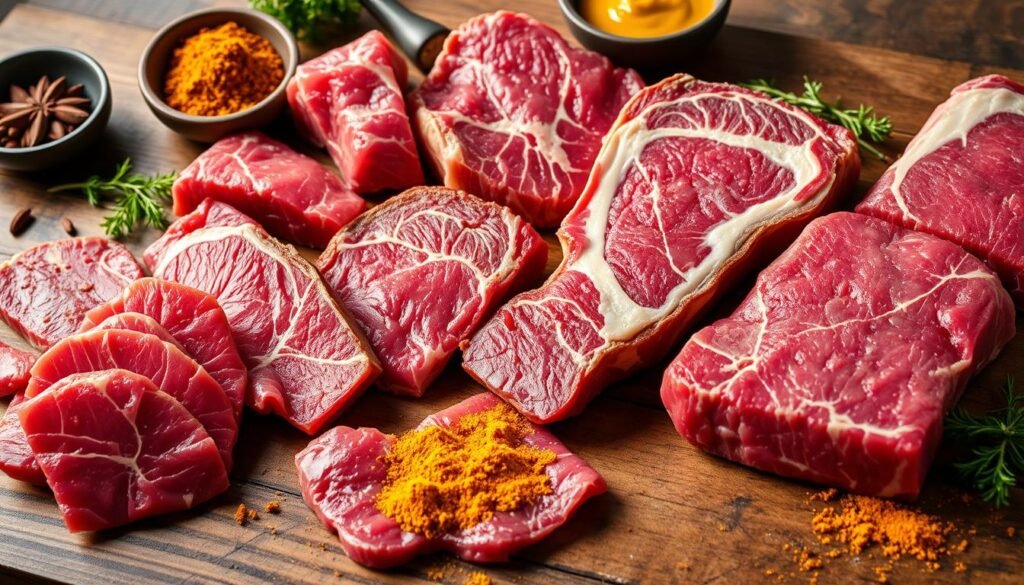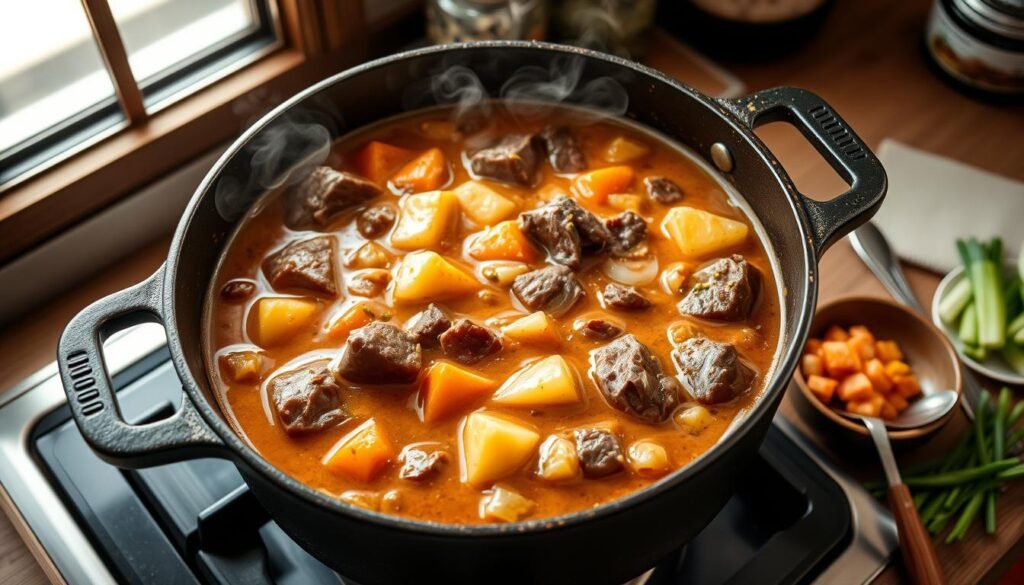Creamy Japanese Beef Curry Recipe with Vegetables
Creamy Japanese Beef Curry Recipe with Vegetables is the ultimate comfort food. It combines simple ingredients into a meal that warms your heart and soul. This dish is a key part of authentic Japanese cuisine, known for its unique flavors and techniques.
This curry is more than just a meal; it’s a cultural experience. It mixes Western cooking with Japanese traditions. Whether you’re a home cook or a food lover, this guide will help you make a dish that rivals a restaurant’s.
Table of Contents
Key Takeaways
- Learn authentic techniques for preparing Japanese beef curry
- Understand the cultural significance of this beloved dish
- Master the art of creating a creamy, flavorful curry
- Discover essential ingredients for an authentic recipe
- Explore traditional cooking methods and tips
Understanding Japanese Beef Curry’s Cultural Significance
Japanese beef curry is more than a meal; it’s a journey into authentic Japanese cuisine. It tells a story of cultural adaptation and innovation. This dish has become a national treasure.
The history of Japanese comfort food is filled with global adventures. Curry came to Japan in the Meiji era, thanks to British naval influences. It brought a mix of flavors that won over Japanese taste buds.
Origins of Curry in Japanese Cuisine
Curry’s introduction to Japan was a fascinating journey. Japanese sailors adapted British naval recipes, making them their own. Key changes included:
- British naval cookbook influences
- Gradual spice modifications
- Creation of a milder, sweeter version
Evolution into a National Comfort Food
What began as a foreign recipe became a staple in Japan. Japanese chefs made curry softer, sweeter, and more appealing to their taste.
Regional Variations Across Japan
Every region in Japan has its own version of beef curry. From Hokkaido’s creamy to Okinawa’s light, it shows local ingredients and traditions.
Today, beef curry is more than food; it’s a symbol of cultural creativity. It shows how food can bridge cultures.
Essential Ingredients for Authentic Japanese Curry
Making an authentic Japanese curry needs the right ingredients. These ingredients turn a simple dish into a masterpiece. Japanese curry has a unique taste that stands out from others.
The base of a tasty Japanese curry is its key ingredients. They add depth and richness:
- Curry Roux: The heart of authentic Japanese cuisine, curry roux provides a thick, smooth base with complex spice combinations
- High-quality beef stock for intense umami flavor
- Fresh vegetables like onions, carrots, and potatoes
- Signature Japanese spices that create a distinctive taste
Choosing the right ingredients is crucial. Chefs say using top-quality parts is key to traditional Japanese cooking.
The secret to a great Japanese curry is balance. Look for these important things:
- Freshly ground spices
- Locally sourced vegetables
- Premium meat cuts
- Authentic Japanese curry roux
Knowing the right ingredients makes your cooking special. It turns meal prep into a true Japanese culinary experience.
Selecting the Perfect Cut of Beef for Your Curry
Making a great wagyu beef curry starts with picking the right meat. The quality of your beef affects how tender and tasty your curry will be. Knowing how to choose and prepare your meat can turn a simple curry into a work of art.

For tender beef chunks in your Japanese curry, some cuts are better than others. These cuts are great for slow cooking because they break down well and soak up lots of flavor.
Best Beef Cuts for Slow Cooking
- Chuck Roast: An ideal option with excellent marbling
- Short Ribs: Rich in flavor and perfect for long cooking times
- Brisket: Develops incredible tenderness when cooked slowly
Wagyu vs Regular Beef Options
Wagyu beef curry is a luxury with its rich marbling and tender texture. While regular beef is good, wagyu takes the dish to a higher level. Wagyu’s high fat content makes the curry more juicy and flavorful.
Meat Preparation Techniques
- Trim excess fat, leaving some for flavor
- Cut beef into uniform 1-inch chunks
- Season generously before cooking
- Brown meat to lock in flavors
Pro tip: For the most tender beef chunks, marinate your meat for 2-4 hours before cooking. This method helps soften the meat and adds more flavor to your wagyu beef curry.
Fresh Vegetables That Complement Japanese Beef Curry
Making the perfect japanese beef curry is more than just meat and sauce. Vegetables are key to boosting flavor and nutrition. The right vegetables can turn your curry from great to amazing.
Traditional japanese beef curry includes a few essential vegetables. These add texture and taste, balancing well with the curry sauce.
- Potatoes: Absorb curry flavors beautifully
- Carrots: Add natural sweetness
- Onions: Provide depth and aromatic base
- Mushrooms: Enhance umami profile
When picking vegetables for your curry, mix old favorites with new ones. Classic choices are great, but trying new veggies can bring exciting flavors.
| Vegetable | Flavor Profile | Cooking Recommendation |
|---|---|---|
| Kabocha Squash | Sweet, creamy | Cut into chunks, adds rich texture |
| Bell Peppers | Crisp, slightly sweet | Add last few minutes of cooking |
| Eggplant | Soft, absorbs flavors | Cube and pre-salt to reduce bitterness |
For even cooking, cut veggies the same size. Pro tip: Put harder veggies like potatoes and carrots in early. Add softer ones later to keep their texture.
Making the Perfect Curry Roux from Scratch
Making a thick curry roux is key to a great Japanese beef curry. It turns simple ingredients into a rich, flavorful dish. This dish comforts and satisfies.
By making your own curry roux, you control the flavor and texture. Unlike store-bought roux, homemade gives you full control over your dish.
Base Ingredients for Homemade Roux
- Unsalted butter (high-quality)
- All-purpose flour
- Curry powder
- Garam masala
- Ground spices (turmeric, cumin, paprika)
Cooking Temperature Guidelines
For a perfect roux, manage the heat carefully. Cook it slowly to let flavors develop without burning.
| Roux Stage | Temperature Range | Cooking Time |
|---|---|---|
| Initial Melt | Low (275-300°F) | 3-4 minutes |
| Flour Integration | Medium-Low (300-325°F) | 5-7 minutes |
| Spice Toasting | Medium (325-350°F) | 2-3 minutes |
Storage and Shelf Life Tips
Proper storage keeps your roux fresh. Store it in an airtight container in a cool, dark place for up to two weeks. Or refrigerate for longer freshness.
- Room temperature storage: 1-2 weeks
- Refrigerated storage: 1-2 months
- Freeze in portioned blocks for easy future use
Mastering roux-making takes your beef curry to the next level. It impresses everyone with your cooking skills.
Step-by-Step Japanese Beef Curry Preparation

Making an authentic japanese beef curry needs careful steps and attention. Your recipe will come to life with a methodical cooking process. This turns simple ingredients into a rich, comforting dish.
Begin by picking high-quality beef cuts. These will become tender during slow cooking. Your meat prep is key to a great japanese beef curry.
- Cube the beef into 1-inch pieces, ensuring uniform size for even cooking
- Season the meat with salt and black pepper
- Heat a large Dutch oven or heavy-bottomed pot with oil
- Brown the beef in batches to develop deep, caramelized flavors
Next, focus on adding layers of flavor through vegetable prep. Dice onions, carrots, and potatoes into consistent chunks. These will blend well with the beef.
- Sauté vegetables until slightly softened
- Add minced garlic and ginger for aromatic depth
- Incorporate homemade or store-bought curry roux
Simmer your japanese beef curry on low heat. This lets the flavors meld and the meat tenderize. This process usually takes 60-90 minutes.
| Cooking Stage | Temperature | Approximate Time |
|---|---|---|
| Meat Browning | Medium-High | 10-15 minutes |
| Vegetable Sautéing | Medium | 5-7 minutes |
| Curry Simmering | Low | 60-90 minutes |
Your patience will be rewarded with a delicious japanese beef curry. It will fill your kitchen with a wonderful aroma.
Mastering the Art of Curry Thickness and Texture
Making the perfect Japanese curry needs focus on its consistency and texture. The roux’s thickness can turn a simple meal into a work of art. Knowing how to adjust your curry’s texture is key to getting that restaurant taste at home.
- Use potato starch for quick thickening
- Incorporate grated apple for natural texture enhancement
- Adjust cooking time to control reduction
- Experiment with roux quantities
Adjusting Consistency Like a Pro
If your curry is too thin, don’t worry. Make a slurry with cold water and potato starch. Slowly add it to your curry while stirring. This keeps the flavor intact while thickening it.
Troubleshooting Texture Challenges
| Curry Issue | Solution | Technique |
|---|---|---|
| Too Thin | Potato Starch Slurry | Gradual Addition |
| Too Thick | Additional Stock | Incremental Dilution |
| Uneven Texture | Continuous Stirring | Low Heat Simmering |
Remember, practice is key with thick curry roux. Each batch teaches you something new about consistency. Trust your instincts and adjust as you go.
Secret Tips for Enhanced Curry Flavor
Unlocking the secrets of traditional Japanese flavors is more than just a recipe. Your Japanese beef curry can go from good to amazing with a few insider tips. These tips will take your authentic Japanese dish to new levels.
Professional chefs say the key to a great curry is layering complex flavors. Here are some techniques to make your curry stand out:
- Add umami-rich ingredients like aged soy sauce or fermented miso paste
- Try unexpected flavor boosters like dark chocolate or brewed coffee
- Caramelize onions slowly for deep, rich flavors
- Use a splash of grated apple or honey for a touch of sweetness
The secret to a top-notch curry is knowing how to develop flavors. Toasting your spices before adding them to the roux makes them more aromatic. Grate fresh ginger or garlic into the pot for bright, vibrant notes that enhance the beef.
True mastery of traditional Japanese flavors comes from patience and careful attention to detail.
Don’t be shy to make your curry your own. Every small change can turn an ordinary dish into a memorable experience. It celebrates the rich world of authentic Japanese cuisine.
Traditional Side Dishes and Accompaniments
When making Japanese curry rice, the right sides can make your meal amazing. This dish is best with side dishes that match its rich flavors.
Classic Rice Pairings
The base of any curry rice is perfectly cooked white rice. Use short-grain Japanese rice for the best taste. Your rice should be:
- Fluffy and slightly sticky
- Warm when served
- Prepared with clean, filtered water
Delightful Garnish and Pickle Options
Enhance your curry rice with these traditional sides:
| Garnish | Flavor Profile | Preparation |
|---|---|---|
| Fukujinzuke | Tangy, sweet pickled vegetables | Finely chopped, fermented mix |
| Rakkyo | Crisp pickled scallions | Whole or sliced pickled onions |
| Soft-boiled Egg | Creamy, rich protein | 6-minute boiled, halved |
Pro tip: Add crispy fried onions or benishoga (pickled ginger) for more texture and taste.
Storage and Reheating Guidelines
Keeping your homemade japanese beef curry fresh is key. It’s important to store and reheat it right. This way, your beef curry stays delicious and safe to eat for days.
- Cool the curry completely before storing
- Use airtight containers with secure lids
- Refrigerate within 2 hours of cooking
- Store in glass or BPA-free plastic containers
How long you can store it depends on your method:
| Storage Method | Maximum Duration | Quality Preservation |
|---|---|---|
| Refrigerator | 3-4 days | Good |
| Freezer | 2-3 months | Excellent |
When reheating, warm it gently to keep its texture. Use medium-low heat and stir often to avoid burning. For the microwave, cover it and use 50% power, stirring halfway.
- Thaw frozen curry in the refrigerator overnight
- Add a small amount of water or broth when reheating to restore moisture
- Heat until the internal temperature reaches 165°F
Pro tip: Never reheat japanese beef curry multiple times, as this can compromise food safety and quality.
Health Benefits of Japanese Beef Curry
Japanese curry is more than just a tasty dish. It’s full of nutrients that can boost your health. The mix of beef, veggies, and spices makes it a healthy choice.
Japanese curry can be a great choice for a balanced diet. It’s all about knowing what’s in it and choosing the right ingredients.
Nutritional Breakdown
A serving of japanese curry offers many important nutrients:
- High-quality protein from beef
- Vitamins A, C, and K from mixed vegetables
- Essential minerals like iron and zinc
- Complex carbohydrates from rice
Dietary Considerations
You can make japanese curry fit different diets:
- Low-sodium option: Use less salt in the roux
- Gluten-free alternatives using specific thickeners
- Lean meat selections for lower fat content
- Vegetable-rich versions for increased nutrition
“A well-prepared japanese curry can be both delicious and nutritionally balanced.” – Traditional Japanese Cooking Expert
By choosing the right ingredients, you can make this dish healthier. It’s possible to enjoy great taste without sacrificing nutrition.
Conclusion
Your journey through authentic Japanese cuisine has ended with learning to make perfect Japanese beef curry. This journey is more than just cooking a meal. It’s about diving into a rich cultural tradition that turns simple ingredients into a comforting dish.
You now know how to pick the best beef, make a rich roux, and balance flavors. These skills let you make Japanese beef curry, a dish loved by many. You can also try different versions and make it your own.
Learning authentic Japanese cuisine is ongoing. Every time you make this dish, you get better and discover new tastes. Your homemade Japanese beef curry is a delicious piece of cultural heritage and culinary skill.
With more practice and passion, your kitchen will become a place where Japanese flavors shine. You’ll create unforgettable meals that celebrate the deep flavors of this beloved comfort food.
🌎Top picks from Amazon📦🛒
🔥 Hearty Irish Beef Stew 🍲🇮🇪 Delicious 🎯 ComfortFood
FAQ
What makes Japanese beef curry different from other curry styles?
Japanese beef curry stands out because of its thick, sweet sauce. This sauce is made from a roux, unlike the thinner sauces found in Indian or Thai curries. The roux gives the curry a smooth texture and a milder taste that many enjoy.
Can I use different types of beef for this curry?
Yes, you can use different beef cuts for Japanese beef curry. Wagyu beef is the most luxurious choice. But, you can also use chuck roast, beef stew meat, or sirloin. Choose cuts that get tender with slow cooking, like those with lots of marbling.
How long does it take to prepare authentic Japanese beef curry?
Making authentic Japanese beef curry takes about 1.5 to 2 hours. This includes browning the meat, sautéing veggies, simmering the curry, and making the roux. The slow cooking is key to getting rich, deep flavors.
Is Japanese beef curry spicy?
Japanese curry is generally mild and savory, not spicy. It has a rich, slightly sweet taste and a smooth texture. You can make it spicier by using different curry roux or adding spices.
What are the best vegetables to use in Japanese beef curry?
Onions, carrots, and potatoes are traditional choices. They add flavor and thicken the curry. You can also try adding bell peppers, mushrooms, or green peas for a personal touch.
Can I make Japanese beef curry gluten-free?
Yes, you can make gluten-free Japanese beef curry. Use gluten-free curry roux or make your own roux with gluten-free flours like rice flour or cornstarch. Many brands now offer gluten-free curry roux that tastes just like the traditional version.
How should I store leftover Japanese beef curry?
Store leftover curry in an airtight container in the fridge for 3-4 days. You can freeze it for up to a month. When reheating, add a bit of water or stock if it’s too thick.
What is the best way to serve Japanese beef curry?
Serve Japanese beef curry over steamed white rice, known as curry rice or karē raisu. Add garnishes like soft-boiled eggs, pickled veggies, or crispy onions for extra flavor and texture.

